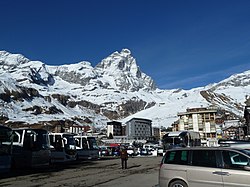Breuil-Cervinia
| Breuil-Cervinia | |
|---|---|
 | |
| Coordinates | 45°56′04″N 7°37′52″E / 45.93444°N 7.63111°E |
| Vertical | 2,347 m (7,700 ft) |
| Top elevation | 3,480 m (11,420 ft) (3,899 m [12,792 ft] on Zermatt side) |
| Base elevation | 2,050 m (6,730 ft) in Breuil-Cervinia (1,524 m [5,000 ft] in Valtournenche) |
| Skiable area | 150 km2 (58 sq mi) Cervinia, 350 km2 (140 sq mi) Cervinia/Zermatt |
| Runs | 56 (200 km [120 mi]) |
| Longest run | 22.5 km (14.0 mi) |
| Lift system | 24 |
| Lift capacity | 40881 skiers/h in Breuil-Cervinia (89831 skiers/h including Zermatt) |
| Website | Official website |
Breuil-Cervinia (Italian: Cervinia; French: Breuil; Valdôtain: Breuil) is an alpine resort in the Aosta Valley region of northwest Italy. It is a frazione of the comune of Valtournenche.
Geography[]

Cervinia lies at 2,006 m (6,581 ft) above sea level, at the foot of the Matterhorn (in Italian, Monte Cervino; in French, Mont Cervin, in patois valtournain, the local dialect, Gran Becca), in a valley surrounded by high, glaciated mountains and the sheer rock face of the Jumeaux. It shares a ski area with Zermatt in Switzerland, connected through the Plateau Rosa glacier (3,500 m [11,500 ft]). Some of the runs are very long, the longest is (nr. 7), which stretches 22 km (14 mi) from the Testa Grigia (in French, Tête Grise) down to Cervinia in Italy. The ski season in Cervinia lasts not only 6 months in winter but also in summer on the glacier Plateau Rosa.[1]
Weather/Climate[]
Cervinia being one of Europe's highest ski resorts means low temperatures and good consistent snow fall, Skiing is nearly year round on the glacier. Temperatures get very cold through the winter months with daily averages being around −5 and −10 °C (23.0 and 14.0 °F) for the winter months and only about 8–10 °C (46.4–50.0 °F) in the summer months. This maintains the snow in great shape throughout the winter season. December usually averages round 40–50 cm (16–20 in) in resort and 140–160 cm (55–63 in) on the mountain, January approx 80 and 200 cm (31 and 79 in), February approx 90 and 220 cm (35 and 87 in), March 100 and 240 cm (39 and 94 in), April 60–200 cm (24–79 in).
The aerial tramway Plateau Rosa, 3,480 m (11,420 ft)

The Matterhorn from Breuil-Cervinia

A view of Breuil-Cervinia slopes
History[]
The town of Breuil-Cervinia has a pretty short history, which fills only the last two centuries. Till the beginning of the 19th century, the Breuil basin was just a giant pasture, with a group of shepherds living in a few alpine cottages only in summer.
The real growth of the town begun since the 1850s, with the birth of the passion for alpinism all over the Alps; in fact many mountain climbers saw the Matterhorn as one of the greatest challenges, so the construction of some bases became necessary. Some examples are the first Refuge du Théodule (in Italian Rifugio Teodulo, built in 1852) at 3317 m (10882.6 ft), the Jumeaux Hotel and Hotel du Cervin.
The first step towards the construction of the ski resort was done in 1934, when some piedmontese entrepreneurs founded the Matterhorn Society (in Italian Società Cervino)), wanting to turn the town in a tourist destination, with modern infrastructures. In 1936 a group of men from Valtournanche understood the need of a skilift linking Breuil to Plan Maison at 2555 m (8382.6 ft) and so it was the beginning of winter tourism.
During 1939 Breuil was renamed Cervinia because of the fascist project of Italianisation of Aosta Valley's town names. 1939 also had been the year of a big venture: the highest skilift in Italy was opened, linking Plan Maison with the Testa Grigia at 3480 m (11417 ft), near the Swiss border.
After the Second World War the growth continued more than ever, with the realization of many lifts, gondolas and the longest cable car of Europe, built in 1952 between Plan Maison and Mount Furggen (used until 1992 and then abandoned). The unification in 1982 with the Valtournanche ski resort added prestige to Cervinia.
Thanks to its rapid growth, Cervinia and its ski resort, as many other town on the Alps like Courmayeur, Chamonix-Mont-Blanc, Limone Piemonte, Pila, Sestriere, Zermatt etc., became a field of architectural and engineering experimentation, trying to develop a new alpine architecture and new technologies for buildings and lifts.
Today Breuil-Cervinia is fully dependent on tourism, both during winter and summer, thanks to the possibility of summer ski on the Plateau Rosa Glacier, the beauty of its alpine landscape and the presence of the Matterhorn (in Italian Cervino).
The town hosted the FIBT World Championships in 1971, 1975, and 1985. In 1987 the town was used as a location for the filming of few episodes of the cult Italian TV Show Licia dolce Licia
Notes and references[]
- Official website (in English, French, German, Italian, and Spanish)
- Breuil-Cervinia Downhill Snow Report from Aosta valley official website (in English, French, German, Italian, and Spanish)
- ^ "Breuil Cervinia". Cervinia. Cervinia. Retrieved 8 October 2018.
- Cities and towns in Aosta Valley
- Frazioni of Aosta Valley
- Ski areas and resorts in Italy



